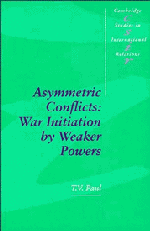Book contents
- Frontmatter
- Contents
- List of tables
- Preface
- PART I THE THEORETICAL FRAMEWORK
- PART II THE CASE STUDIES
- 3 The Japanese offensive against Russia, 1904
- 4 The Japanese attack on Pearl Harbor, 1941
- 5 The Chinese intervention in Korea, 1950
- 6 The Pakistani offensive in Kashmir, 1965
- 7 The Egyptian offensive in the Sinai, 1973
- 8 The Argentine invasion of the Falklands/Malvinas, 1982
- Conclusion
- Notes
- Bibliography
- Index
- Titles in the series
6 - The Pakistani offensive in Kashmir, 1965
Published online by Cambridge University Press: 03 May 2011
- Frontmatter
- Contents
- List of tables
- Preface
- PART I THE THEORETICAL FRAMEWORK
- PART II THE CASE STUDIES
- 3 The Japanese offensive against Russia, 1904
- 4 The Japanese attack on Pearl Harbor, 1941
- 5 The Chinese intervention in Korea, 1950
- 6 The Pakistani offensive in Kashmir, 1965
- 7 The Egyptian offensive in the Sinai, 1973
- 8 The Argentine invasion of the Falklands/Malvinas, 1982
- Conclusion
- Notes
- Bibliography
- Index
- Titles in the series
Summary
The second Kashmir War between India and Pakistan began on August 5, 1965 with the infiltration of specially trained guerrillas into Indian held Kashmir from Pakistani controlled Azad Kashmir. The initial Pakistani operation, code-named “Gibraltar,” was actively planned and implemented by officials from Pakistan's Foreign Ministry and Army and was intended to capture the Kashmir Valley from India through urban insurrection. If that mission failed, the operation was expected to raise the prospects for serious negotiations by bringing the Kashmir issue to renewed international focus.2 The important question for this study is why did the Pakistani leaders decide to commit to a military solution to the Kashmir dispute in September 1965 even when they knew that India held a nearly 3:1 numerical advantage in the Kashmir theater and a 5:1 superiority in overall military and industrial capability?
The balance of capabilities in 1965 was as follows. The Indian armed forces comprised 870,000 men in sixteen divisions as compared to Pakistan's 230,000 under eight divisions. Of the sixteen divisions, India had deployed two infantry divisions in Kashmir and eight along its border with Pakistan and the rest on the Chinese border. Pakistan had a total of seven divisions confronting India in West Pakistan and one division in East Pakistan. India possessed two armored divisions, one each of Centurion and Sherman tanks; while Pakistan had one armored division with American built M-47/48 Patton tanks, and a few other regiments with M-4 Sherman medium tanks and M-24 Chaffee light tanks.
- Type
- Chapter
- Information
- Asymmetric ConflictsWar Initiation by Weaker Powers, pp. 107 - 125Publisher: Cambridge University PressPrint publication year: 1994
- 1
- Cited by



